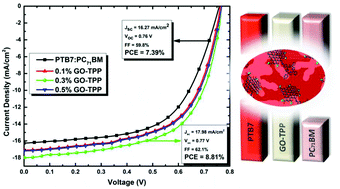Efficient ternary organic photovoltaics incorporating a graphene-based porphyrin molecule as a universal electron cascade material†
Abstract
A graphene-based porphyrin molecule (GO-TPP) was synthesized by covalent linkage of graphene oxide (GO) with 5-(4-aminophenyl)-10,15,20-triphenyl porphyrin (TPP-NH2). The yielded graphene-based material is a donor–acceptor (D–A) molecule, exhibiting strong intermolecular interactions between the GO core (A) and the covalently anchored porphyrin molecule (D). To demonstrate the universal role of GO-TPP as an electron cascade material, ternary blend organic photovoltaics based on [6,6]-phenyl-C71-butyric-acid-methyl-ester (PC71BM) as an electron acceptor material and two different polymer donor materials, poly[N-9′-hepta-decanyl-2,7-carbazole-alt-5,5-(40,70-di-2-thienyl-20,10,30-benzothiadiazole)] (PCDTBT) and the highly efficient poly({4,8-bis[(2-ethylhexyl)oxy]benzo[1,2-b:4,5-b′]dithiophene-2,6-diyl}{3-fluoro-2-[(2-ethylhexyl)carbonyl]thieno[3,4-b]thiophenediyl}) (PTB7), were fabricated. The addition of GO-TPP into the active layer implies continuous percolation paths between the D–A interfaces, enhancing charge transport, reducing exciton recombination and thus improving the photovoltaic performance of the device. A simultaneous increase of short circuit current density (Jsc), open-circuit voltage (Voc) and fill factor (FF), compared to the PTB7:PC71BM reference cell, led to an improved power conversion efficiency (PCE) of 8.81% for the PTB7:GO-TPP:PC71BM-based device, owing mainly to the more efficient energy level offset between the active layer components.



 Please wait while we load your content...
Please wait while we load your content...